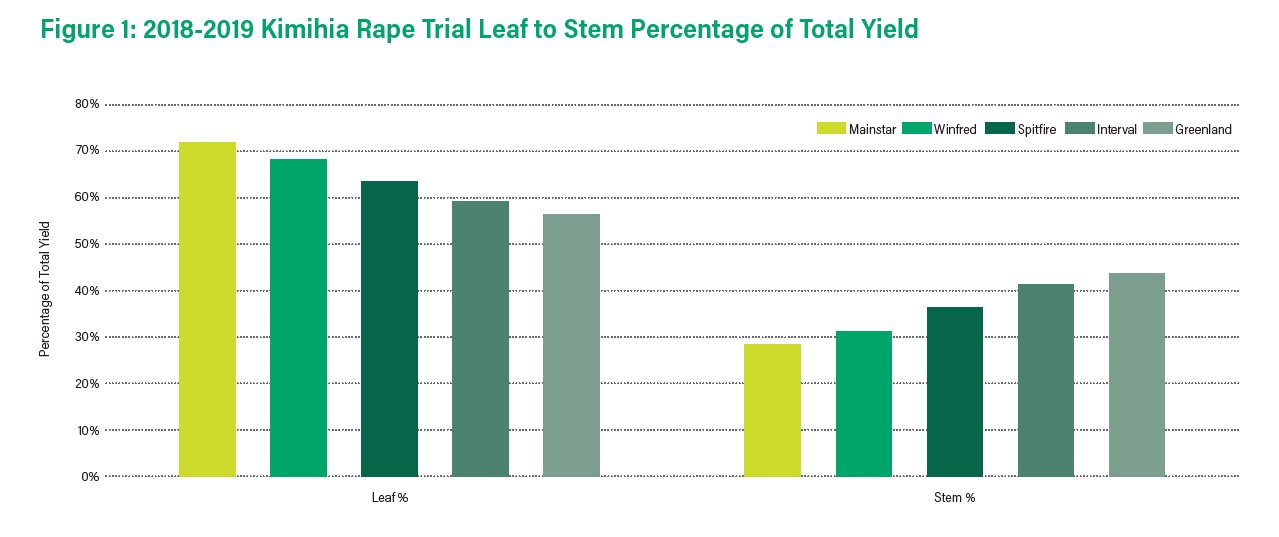07Jan
High yielding rapes for excellent summer feed
Words and images supplied by Agricom.
When it comes to selecting a rape cultivar for summer feed, it is important to base this decision on the potential yield needed at key times. There are, however, other important factors to take into consideration. One that is often overlooked is the quality and palatability of the stem. Another key trait that must be considered is the plant's natural ability to combat aphid pressure. When properly balanced, these three factors will not only ensure a reliable yield but will maximise the plant’s quality and it’s re-growth potential.
Spitfire and Mainstar forage rapes from Agricom are New Zealand-bred cultivars with very high utilisable yield for their types. Recent trials have confirmed that Spitfire and Mainstar have excellent yield in both their leaf and stem at the first grazing and have a high total yield when combined (see figure 1).
It is the excellent aphid resistance, high leaf yield and utilisation that makes these varieties different. Farmers have been impressed with how healthy and clean plants are during the growing season, especially when they compare them to other cultivars sown at the same time. High aphid tolerance makes management a lot easier, saves on insecticide use and contributes to a high leaf proportion in the crop at grazing.
Many cultivars can look just as impressive for height and yield at grazing but can disappoint farmers with the amount of the crop that stock are reluctant to eat. The most important determinant for the real productivity of a forage rape is the proportion of leaf to stem and how much is eaten by animals – often described as the edible dry matter. Famers have found that their stock perform very well on Mainstar and Spitfire, which is mainly down to the high proportion of green leaf in the diet.
Mainstar is Agricom’s new early-maturing rape cultivar with the time to first grazing being 10 to 12 weeks. If managed correctly, Mainstar can be grazed 3 times and, for some a 4th grazing is possible if mixed with herbs such as Ecotain® environmental plantain. This provides a much wider grazing window starting in early summer and going through autumn into early winter. It has been noted in grazing preference trials the vast difference in crop residue post-graze when animals have a choice of which cultivars to graze.
Spitfire can be planted in spring to provide grazings over summer. The time to first grazing is 13 to 14 weeks and often two good grazings can be achieved before shutting up for winter feed or being direct drilled into in early autumn for winter feed. Establishment and management are similar to other rapes, except that aphid spraying is likely to be required at a lower frequency while some stressed crops may still need an insecticide. Spitfire is ideal for situations where the feed pinch occurs in mid-summer and animal feed requirements are high.
The forage rape grazing management defined by Agricom’s research should be followed to maximise stock performance and crop regrowth. Herbs and clovers can also be planted with Spitfire and Mainstar to produce a high-quality pasture after the rape has thinned out.
Having both an early maturing multi-graze type in Mainstar and a high yielding summer dominant variety in Spitfire gives farmers options. Rape is widely respected as a crop that is very tolerant to drought conditions and in times of uncertainty, becomes an integral part of many farm systems. If farmers are after proven, modern, high-performance rape cultivars with crucial added benefits, they should look no further than Spitfire or Mainstar.
For more information on Spitfire or Mainstar contact your local Ruralco representative.
Figure 1: shows how the yield of each cultivar in the trial was made up between the leaf and the stem. The average yield in 86 days was 11 t DM/ha and, as can be seen in the Mainstar data, the majority of yield comes from the leaf, which in turn results in more being consumed.

Related

Filling in pivot ruts and retrieving material from under dairy lane fences has never been easier wit...
Read More

Dairy beef makes up the bulk of this country’s beef exports and by using the correct beef genetics,...
Read More

Sulphur deserves more attention that it gets. It is important for plants, cheap and can easily be in...
Read More

If there’s one thing aphids like, apart from feeding on young wheat and barley seedlings, it’s war...
Read More

A penchant for trying new crops coupled with a need to find a viable alternative to growing traditio...
Read More

History said she was just a man’s muse. History was wrong. The exquisite new novel from bestselling...
Read More